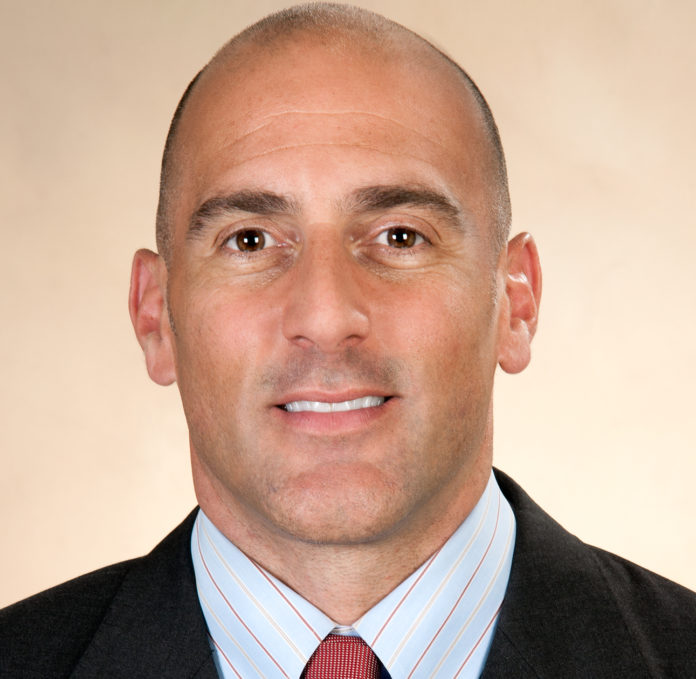
Dr. Alexios Carayannopoulos is an osteopathic physician who is board-certified in physical medicine and rehabilitation as well as in pain medicine. The medical director of the Rhode Island Hospital Comprehensive Spine Center (a Lifespan facility), which specializes in surgical and nonsurgical spine management, he is also an assistant professor of neurosurgery at The Warren Alpert School of Medicine of Brown University.
A Harvard University-trained medical acupuncturist and a U.S. Navy veteran, Carayannopoulos is a regular participant in Gov. Gina M. Raimondo’s Overdose Prevention and Intervention Task Force. He spoke recently with Providence Business News about the American College of Physicians guidelines de-emphasizing pharmaceutical treatments for lower back pain and focusing on a more holistic approach to pain management.
PBN: Describe the American College of Physicians new guidelines for treating low back pain.
CARAYANNOPOULOS: The new clinical practice guidelines by the American College of Physicians were developed to present the evidence and provide clinical recommendations to clinicians on noninvasive treatments for low back pain. These were created by conducting a systematic review of literature on noninvasive treatments for low back pain.
These clinical practice guidelines recommendations overall emphasize the importance of nonpharmacologic treatments, including exercise, multidisciplinary rehabilitation, acupuncture, mindfulness therapy, tai chi, yoga, motor-control exercise, relaxation, biofeedback, low-level laser, psychological management and spinal manipulation. The guidelines suggest that pharmacologic treatments should include adjuvant non-opioid medications, which include anti-inflammatories, muscle relaxants, nerve-pain killers or specific anti-depressants indicated for pain. The guidelines suggest that opioids should only be used as a last resort.
PBN: Do you think they offer appropriate guidance to physicians, and how will they be communicated?
CARAYANNOPOULOS: The updated guidelines do offer appropriate guidance to physicians, and they will be promulgated through local and national medical societies and academies. The ACP recognizes that its recommendations may not apply to all patients or clinical scenarios, nor are the recommendations intended to override clinical judgment. The ACP values the importance of a comprehensive and individualized assessment and plan for every patient presenting with low back pain. Furthermore, the ACP recognizes the importance of a combined medical, psychological, complementary and surgical continuum of care, while emphasizing use of the most-conservative options first.
PBN: According to the guidelines, most patients with acute or sub-acute low back pain improve over time, regardless of treatment. Given that, what can – or should – be done to reduce the rush to treatments, via physical therapy, steroid shots, chiropractic treatments and/or surgery?
CARAYANNOPOULOS: Education and reassurance are the keys to avoid the rush to more invasive treatment options. After performing a thorough history and physical examination to assess for mechanical instability or neurologic dysfunction, which might suggest the need for surgery, clinicians should reassure patients that most back pain is self-limited. Patients should be educated about the nonpharmacologic treatments outlined in the new guidelines.
Steroid shots and chiropractic treatment can be pursued to control pain; however these options should be performed in conjunction with rehabilitation, which includes physical or occupational therapy and therapeutic exercise in order to improve function. Alternative options such as yoga, massage, tai chi and acupuncture should be considered as adjuncts to control pain. To avoid unnecessary invasive approaches, patients with back pain should always be screened for depression and anxiety, which might amplify pain and may better respond to psychological counseling, which can improve both mood as well as pain.
PBN: Are patients with back pain more likely than patients with other medical conditions to rely on opioids?
CARAYANNOPOULOS: Yes, patients with back pain are more likely to rely on opioids than patients with other medical conditions. Fortunately, with the growth of comprehensive pain clinics and spine centers such as Rhode Island Hospital’s Comprehensive Spine Center, patients now have access to an array of nonpharmacologic treatment options and education. At our spine center, we have excellent surgeons and interventionists and we value the need for invasive options when needed; however, we recognize the importance of trying the least-invasive options first.
By guiding and encouraging patients to pursue options such as exercise, yoga and nonpharmacologic treatments first, we have found that the recurrence and chronicity of low back pain will likely be diminished. Furthermore, this approach not only lowers the overall cost of health care, but empowers patients to take individual control of their pain.
PBN: Tell us more about your efforts, both as a physician and as a participant in the Governor’s Task Force, to change the conversation about opioids as the first line of pain-management defense?
CARAYANNOPOULOS: Through communication and education, the Comprehensive Spine Center has been engaging in community outreach since its inception. As a pain physician and regular participant in the Governor’s Opioid Task Force, I have lectured on the importance of an interdisciplinary, comprehensive spine care approach to manage low back pain in an effort to educate practitioners and the public about non-opioid options.
Furthermore, my program manager, Gail Grande, and I are involved with developing a pilot program through the Rhode Island Department of Health to guide the primary care community in Rhode Island to address spine-related pain without the use of opioid medications. Additionally, I serve on multiple national and international committees and conduct research to promote education on the use of non-opioid treatment options, including neuromodulation to control pain and to improve function.
Nancy Kirsch is a PBN contributing writer.












